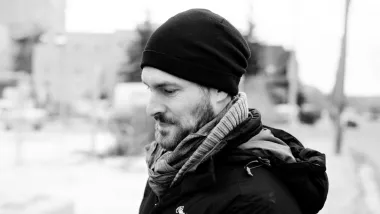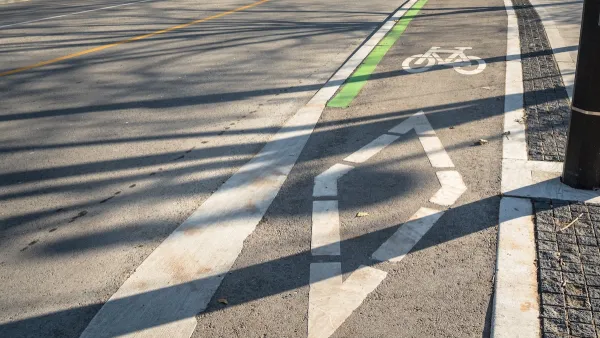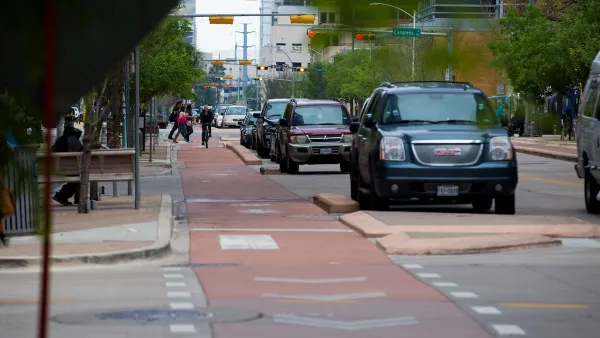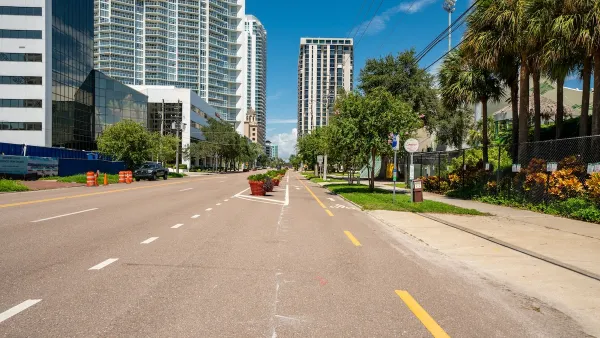Being on the street used to be a dance, but not so since the automobile took over. Is there a way for all modes to coexist through a mutual ethic rather than compete for a street’s right of way?
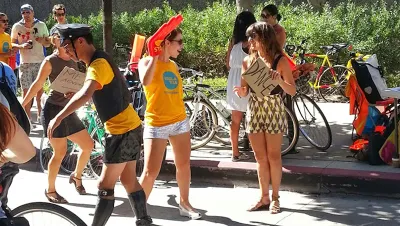
Get ready cities, here come the bike lanes! Although it’s the trendy topic these days, cycling has been a mode of urban transportation for well over a hundred years. To quote LL Cool J: “Don’t call it a comeback, I been here for years, rockin’ my peers and putting suckas in fear!”
After having been marginalized by the march of the automobile, bicyclists are starting to bob and weave their way back onto city streets. It isn’t much of a fight. Cyclist vs. driver might be hosted in the same ring but clearly they aren’t in a competing weight class.
Instead of equalizing the contenders, our current tactic is to cancel the main event and relegate users to their corridors of movement: sidewalks, bike lanes, driving lanes. It’s the perceived safe and reasonable thing to do. But now a new fight: the battle to get bike lanes onto streets. Sorry drivers—good-bye driving lanes and parking stalls! Slowly the city is wresting itself from the automobile’s grip. And to get people out of their cars it’ll take no less than appropriate, convenient and beautiful bicycle infrastructure. That should quell our tendency to believe the car is the right way of urban living. But sometimes our enabling infrastructure can have unintended consequences. Can a bike lane be detrimental to cyclists?
Being on the street used to be a dance. The first motorists had to sashay, moonwalk or perhaps twerk with the other dancers on the street. A motorist had to negotiate with other users; he had to pay attention to a pedestrian, a horse drawn carriage, a cyclist. But soon, as with our modern tendency to separate faculties for efficiency, the social and physical infrastructures were put in place to enable the automobile. In the musical chairs of using the street the car caught the last seat. The walker was literally cast aside, to the sidewalk. As the automobile continued to advance, so cities came to be designed for them—gas stations, wider streets, clover-leafs, suburbs, sound walls, garages, big box stores and on and on. And with this the incapacitation of other forms of transportation.
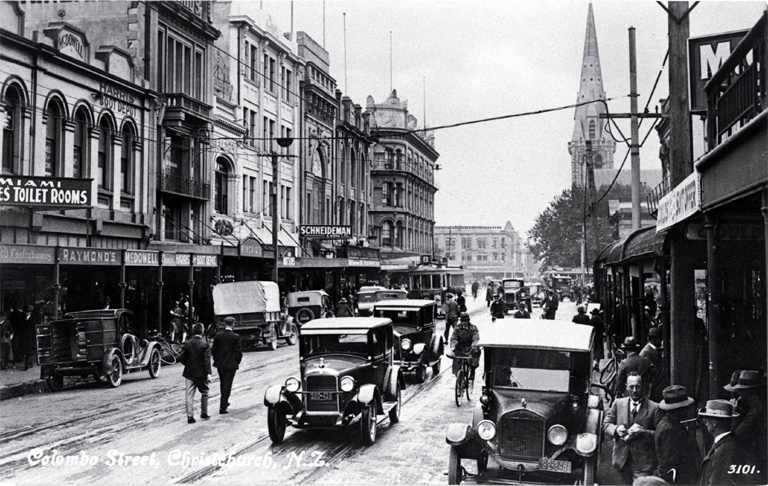
And now we’re left with our urban legacy: cities designed for the car. But we’ve been living in cities for thousands of years, and little is static in the manifestation of our desires, of all our mixed and muddled dreams and wishes. We’re becoming aware that perhaps the automobile isn’t the best way to orient the city. Maybe cities should be more people-scale oriented. And here’s the rub: instead of returning to the dance, we’re marching away.
For a quick cycling win we paint lines on a street, put up signage, and claim a success. “Here be bike lane!” And it is a success. But it’s also still a bike lane in an auto-oriented street—or even an auto-oriented neighbourhood. The lane might help a bit, it’s good for optics and awareness-raising, but in the winter it tends to be where the snow gets plowed, along with the accompanying gravel. During winter’s thaw, or rain showers, it’s where the cyclist goes to be sprayed by passing motorists. Sometimes they’re closed during non-commuting hours. But these design shortcomings have a deeper psychological shortcoming:
There’s no shared ethic, no negotiation; there’s no more dancing!
But who wants to dance with a car rushing by at 50, 60, 80 km/h?
Party crashers should be relegated to a wallflower, relegated to arterial roads. That’s where those speeds belong. But they can be invited onto the dance floor. They’ll just have to slow down a little. Instead of relegated to marching, let’s embrace dancing. Design streets for a shared ethic, for sharing space. It’s where the community is; it feels like a place; it’s where people dance, live,be.
And maybe, just maybe, a motorist will see this, will want to let go her car, ask her city administrators and councillors for dance-able streets. Yes, dance-able! Streets, as Lewis Mumford might have said, are for lovers. Communities, by definition, are places of sharing, so let’s share the road too, make it dance-able, not just for walkers and cyclists and drivers but for dancers. The transportation system is a complex one but there is indeed room in it for negotiating the use of its space. Bring on dance-ability!
To help get you onto the dance floor, here’s Daft Punk featuring Pharrell Williams to lift you up out of your seat!
I know you don't get a chance to take a break this often
I know your life is speeding and it isn't stopping
Here take my shirt and just go ahead and wipe up all the
Sweat, sweat, sweatLose yourself to dance
Lose yourself to dance
Lose yourself to dance
Lose yourself to danceLose yourself to dance
Lose yourself to dance
Lose yourself to dance
Lose yourself to dance
Connect with Steven on Twitter @stevenpsnell or Facebook stevenpsnell.
His novel, The Undergraduates, is available for download here, or at any fine ebook retailer.

Analysis: Cybertruck Fatality Rate Far Exceeds That of Ford Pinto
The Tesla Cybertruck was recalled seven times last year.

National Parks Layoffs Will Cause Communities to Lose Billions
Thousands of essential park workers were laid off this week, just before the busy spring break season.

Retro-silient?: America’s First “Eco-burb,” The Woodlands Turns 50
A master-planned community north of Houston offers lessons on green infrastructure and resilient design, but falls short of its founder’s lofty affordability and walkability goals.

Test News Post 1
This is a summary

Analysis: Cybertruck Fatality Rate Far Exceeds That of Ford Pinto
The Tesla Cybertruck was recalled seven times last year.

Test News Headline 46
Test for the image on the front page.
Urban Design for Planners 1: Software Tools
This six-course series explores essential urban design concepts using open source software and equips planners with the tools they need to participate fully in the urban design process.
Planning for Universal Design
Learn the tools for implementing Universal Design in planning regulations.
EMC Planning Group, Inc.
Planetizen
Planetizen
Mpact (formerly Rail~Volution)
Great Falls Development Authority, Inc.
HUDs Office of Policy Development and Research
NYU Wagner Graduate School of Public Service
























